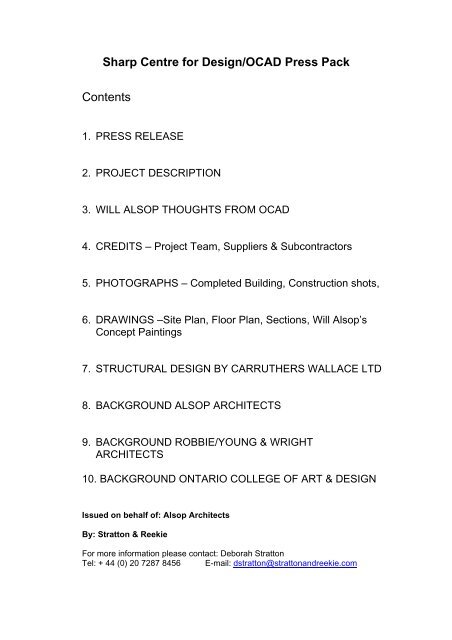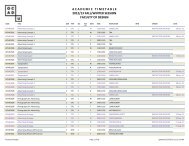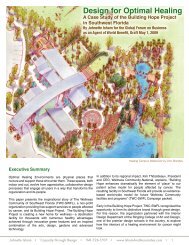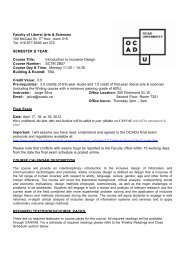Sharp Centre for Design/OCAD Press Pack
Sharp Centre for Design/OCAD Press Pack
Sharp Centre for Design/OCAD Press Pack
You also want an ePaper? Increase the reach of your titles
YUMPU automatically turns print PDFs into web optimized ePapers that Google loves.
<strong>Sharp</strong> <strong>Centre</strong> <strong>for</strong> <strong>Design</strong>/<strong>OCAD</strong> <strong>Press</strong> <strong>Pack</strong><br />
Contents<br />
1. PRESS RELEASE<br />
2. PROJECT DESCRIPTION<br />
3. WILL ALSOP THOUGHTS FROM <strong>OCAD</strong><br />
4. CREDITS – Project Team, Suppliers & Subcontractors<br />
5. PHOTOGRAPHS – Completed Building, Construction shots,<br />
6. DRAWINGS –Site Plan, Floor Plan, Sections, Will Alsop’s<br />
Concept Paintings<br />
7. STRUCTURAL DESIGN BY CARRUTHERS WALLACE LTD<br />
8. BACKGROUND ALSOP ARCHITECTS<br />
9. BACKGROUND ROBBIE/YOUNG & WRIGHT<br />
ARCHITECTS<br />
10. BACKGROUND ONTARIO COLLEGE OF ART & DESIGN<br />
Issued on behalf of: Alsop Architects<br />
By: Stratton & Reekie<br />
For more in<strong>for</strong>mation please contact: Deborah Stratton<br />
Tel: + 44 (0) 20 7287 8456 E-mail: dstratton@strattonandreekie.com
1. PRESS RELEASE<br />
ALSOP SOARS OVER TORONTO<br />
Alsop Architects’ radical design <strong>for</strong> the Ontario College of Art & <strong>Design</strong> (<strong>OCAD</strong> ) in<br />
Toronto will be complete in the summer 2004. <strong>Design</strong>ed in collaboration with<br />
Toronto-based architects Robbie/Young + Wright, the spectacular new building will<br />
be known as the <strong>Sharp</strong> <strong>Centre</strong> of <strong>Design</strong> in honour of its main benefactors, Rosalie<br />
and Isadore <strong>Sharp</strong>.<br />
The remarkable ‘table top’ superstructure, that takes the <strong>for</strong>m of a parallelepiped (9m<br />
high, 31m wide and 84m long), with striking black and white pixellated skin, stands<br />
26 metres above the ground on 12 multi-coloured legs. The structure provides two<br />
storeys of studio and teaching space and is connected to the existing facility below<br />
by an elevator and stair core that <strong>for</strong>ms the central focus of the newly created<br />
entrance hall uniting the two halves of the existing College buildings at all levels. This<br />
new space comprises a new four-storey Entrance Hall, which is entered through a full<br />
height glass façade, and a three-storey Great Hall on Level 2, where students and<br />
artists can exhibit their work. This will be an important centre <strong>for</strong> social activity and a<br />
valuable gathering space <strong>for</strong> events, with a gallery, auditorium, café and conference<br />
centre immediately adjacent.<br />
The unique landmark development ($42.5m) provides <strong>OCAD</strong> with an additional 6,215<br />
sqm of space while at the same time creating a linkage between the College, the<br />
street and Grange Park to the west. The park will also benefit from the area’s<br />
regeneration and, it is expected, may eventually be home to more arts-related<br />
events.<br />
The Ontario College of Art & <strong>Design</strong> marked the completion of the project by<br />
awarding an Honorary Doctorate to architect Will Alsop in June 2004.<br />
ENDS<br />
Issued on behalf of: By:<br />
Alsop Architects Stratton & Reekie<br />
For more in<strong>for</strong>mation please contact<br />
Deborah Stratton<br />
Tel: + 44 (0) 20 7287 8456<br />
June 2004 E-mail: dstratton@strattonandreekie.com<br />
<strong>Sharp</strong> <strong>Centre</strong> <strong>for</strong> <strong>Design</strong>/<strong>OCAD</strong> <strong>Press</strong> <strong>Pack</strong><br />
Alsop Architects<br />
2
2. PROJECT DESCRIPTION<br />
Introduction<br />
For three years, Alsop Architects (Alsops) and Robbie/Young + Wright Architects<br />
(RYWA) have been working in collaboration on the design of an 67,000 sq ft (6,215<br />
sqm) addition and the majority of the 220,000 sq. ft (20,408 sqm) renovation project<br />
<strong>for</strong> the Ontario College of Art & <strong>Design</strong> (<strong>OCAD</strong>) in Toronto. The College’s campus<br />
expansion project also includes 17,000 sq ft of existing space purchased by the<br />
College. Commencing on site in May 2002, the project is scheduled <strong>for</strong> completion in<br />
September of 2004.<br />
Brief<br />
A distinctive cultural <strong>for</strong>ce in Ontario, <strong>OCAD</strong>’s impetus to expand comes with the<br />
Government’s double cohort initiative of 2003, where two years of students<br />
graduated at the same time, which required a rapid expansion in educational facilities<br />
across the province. A growing recognition in government of the creative industries<br />
importance to Canada’s modern economy released $24 million in funding from the<br />
Public Infrastructure Renewal (<strong>for</strong>merly the SuperBuild Growth Fund) <strong>for</strong> expansion<br />
and renovations to the College’s existing campus buildings.<br />
Site Location<br />
The College is situated west of Toronto’s central business district, bordered to the<br />
north by the Art Gallery of Ontario, to the west by the historic Grange Park, and<br />
bounded by St. Patrick Street and Grange Road to the east and south respectively.<br />
Most of the College’s seven buildings are on McCaul St.<br />
Existing Building<br />
Successive extensions to the College buildings over the years had succeeded in<br />
expanding its facilities, but a lack of recent investment and funding had left it critically<br />
lacking in good quality studio and gallery space necessary to meet the requirements<br />
of today’s students. A surface parking lot immediately to the south of the main<br />
campus 100 McCaul St. building had been identified as the site <strong>for</strong> a new addition to<br />
house the Faculty of <strong>Design</strong>. A capital campaign was instigated to raise the<br />
remaining funds from the private sector to complete the expansion and refurbishment<br />
of <strong>OCAD</strong>’s campus facility.<br />
Appointment<br />
The College wanted an architect with a significant track record in the design of<br />
cultural buildings of enduring effectiveness and appeal that could offer an iconic<br />
representation of the client body as the school enters a new age. A chance reacquaintance<br />
between two <strong>for</strong>mer students from the Bartlett led, in 2000, to Alsop<br />
Architects appointment <strong>for</strong> the project in collaboration with RYWA of Toronto.<br />
The team of Alsop and RYWA was attractive to the College <strong>for</strong> a number of key<br />
reasons. First, Alsop brought to the project an international reputation <strong>for</strong><br />
successfully completing provocative urban projects predicated on commitment to art<br />
education, urban renewal, and community consultation. Second, RYWA’s own<br />
national and local reputation <strong>for</strong> completing demanding, fast-tracked projects, both by<br />
themselves and in complex joint ventures, gave the College a com<strong>for</strong>t level that the<br />
design team would be cognizant of the local needs and deliver a remarkable project<br />
that would challenge and satisfy the needs of the College.<br />
<strong>Sharp</strong> <strong>Centre</strong> <strong>for</strong> <strong>Design</strong>/<strong>OCAD</strong> <strong>Press</strong> <strong>Pack</strong><br />
Alsop Architects<br />
3
Despite the physical distance between the two offices, Alsops and RYWA were able<br />
to successfully harmonize their respective strengths into a seamless and focused<br />
operation. With Alsops leading the project as <strong>Design</strong> Architect and RYWA, assuming<br />
the role as Architect-of-Record, managing the production of all drawings and<br />
specifications from concept design through to construction documentation, the teams<br />
operating from offices in London and Toronto were able to deliver the project<br />
effectively within the demanding project schedule.<br />
Consultation<br />
Following the appointment to the project, Will Alsop instigated a series of client<br />
workshops in which early concepts were developed with college staff and students.<br />
During this time, conventional ideas of teaching, learning and architecture were<br />
explored as the group sought to re-define their new college of art and design. The<br />
participants of the workshops exchanged sketches and ideas to investigate what their<br />
future college should be.<br />
Among the many opinions put <strong>for</strong>ward, similar themes emerged. The College needed<br />
to engage with the public and provoke interest, provide meeting places inside and<br />
out, improve circulation within the main building, find new ways to show student work,<br />
provide rough/tough studio spaces where students from different disciplines could<br />
engage and collaborate with each other create flexible spaces that can be reconfigured,<br />
as required, engage with the park, engage with local residents, and raise<br />
the Colleges profile globally and nationally.<br />
Schematic <strong>Design</strong><br />
Two strong ideas that emerged from the workshops were a) a cluster of towers<br />
raised up off the parking lot site and b) a large box or ‘table top’ that was elevated<br />
above the existing school and neighbouring residential properties, allowing Grange<br />
park to re-engage with McCaul Street. The two schemes were presented to the client<br />
group, who came to the conclusion that the ‘table-top’ solution best addressed the<br />
ideas raised in the workshops.<br />
The local residents and the City of Toronto were also included during the early<br />
stages of the design process. They were invited to a presentation of the table-top<br />
scheme given by Will Alsop at the College, followed by a discussion session where<br />
views were heard and ideas exchanged. This not only helped to develop the design<br />
of the scheme but also gave the local residents a sense of inclusion in the design<br />
process and ownership of the scheme.<br />
The idea to elevate the new addition nine storeys above the street on slender legs<br />
proved popular with neighbours, as their views across the street to the park beyond<br />
could, by and large, be maintained. It also allowed the <strong>for</strong>mer parking lot to the south<br />
of the existing building to be landscaped as an extension of the park, to be<br />
programmed with outdoor art exhibitions and other events.<br />
The table-top proposal was outside the early massing study and maximum height<br />
envelopes developed <strong>for</strong> the site. However, by raising the scheme up beyond this<br />
envelope, the City quickly realised the benefit <strong>for</strong> local people by bringing the park<br />
through to McCaul Street, creating a quasi-public space below and maintaining the<br />
majority of views enjoyed by neighbours opposite.<br />
During schematic design, the table top developed into a long box on legs, parallel to<br />
McCaul Street, stretching 163m from the north property line, all the way to the south<br />
property line. It had a double skin façade to naturally cool and heat the building, with<br />
<strong>Sharp</strong> <strong>Centre</strong> <strong>for</strong> <strong>Design</strong>/<strong>OCAD</strong> <strong>Press</strong> <strong>Pack</strong><br />
Alsop Architects<br />
4
a glowing polycarbonate soffit with pod like structures hanging below and a deck<br />
space suspended between the existing building and the table top.<br />
As the project progressed the scale of the project was reduced and the scheme<br />
simplified, largely due to the challenges of designing within a tight budget and with a<br />
limited palette of materials.<br />
<strong>Design</strong> Development<br />
These original ideas are embodied in the final scheme -- a flying, vividly patterned<br />
‘table top’ with a pixellated skin of black on white raised nine storeys from the ground<br />
and housing the new Faculty of <strong>Design</strong>.<br />
The scheme makes imaginative and playful use of the limited palette of materials that<br />
are af<strong>for</strong>dable <strong>for</strong> the client and readily available in Canada.<br />
By improving circulation in the existing buildings and providing new links in the table<br />
top, the project succeeds in unifying the existing brick structures beneath, the park to<br />
the west and McCaul Street to the east.<br />
In addition to the teaching and administrative spaces the project also incorporates<br />
gallery spaces, design and research centres, lounge and meeting areas, and design<br />
critique spaces. Most important, the inefficient layout of the existing buildings was<br />
dramatically improved by reorganizing the primary circulation around a new main<br />
entrance and Great Hall, created by infilling an existing internal open courtyard.<br />
In a climate of extremes, where the winters are very cold and the summers hot and<br />
humid, it was important to create an environment that maximized available space and<br />
was com<strong>for</strong>table and useable throughout the year.<br />
Construction<br />
One of the main challenges faced during the construction period was ensuring that<br />
the College could continue operating while the table top was being constructed<br />
above them. Additionally, due to the compact nature of the site and the proximity to<br />
adjacent buildings, the construction crew did not have the benefit of a large yard in<br />
which to store materials and setup equipment. As such, large steel members – some<br />
as large as 20 tonnes – were immediately hoist and set into place as they were<br />
delivered to the site. The whole construction process offered a unique opportunity to<br />
pedestrians and on-lookers as they were able to see all the work happening be<strong>for</strong>e<br />
them and above them.<br />
Due to the unique nature of the structure and the challenge of erecting the splayed<br />
columns, PCL Constructors, the general contractor <strong>for</strong> the project, set about<br />
constructing the building in the same way that a suspension bridge would be<br />
constructed. The concrete core, containing the elevators and stairs, was erected first<br />
and then the steel structure followed. Upon completion of this core the contractor<br />
systematically worked north and south from the core, first erecting the splayed<br />
columns and then framing these into the super-structure of the table-top. From the<br />
delivery of the first pair of legs to the site, in the first week of July 2003 to the<br />
completion of the framing of the table top in October the erection of the steel was<br />
completed in eighteen weeks.<br />
The legs were fabricated off-site. Due to the oversized diameter of the steel sections<br />
used in the legs, it was necessary to use steel pipe commonly available to the oil<br />
industry, <strong>for</strong> the fabrication of the main columns. The fabrication process included<br />
priming and welding individual sections that were then fireproofed and painted in a<br />
<strong>Sharp</strong> <strong>Centre</strong> <strong>for</strong> <strong>Design</strong>/<strong>OCAD</strong> <strong>Press</strong> <strong>Pack</strong><br />
Alsop Architects<br />
5
specially constructed tent structure at the steel yard. The finished legs, 29m in<br />
length, were placed in pairs on tractor-trailer rigs similar to those used in the logging<br />
industry, and hauled to site in Toronto, 120km away.<br />
The table top’s exterior cladding, affixed on site, consists of a field of white aluminum<br />
and a random pattern of black squares and rectangles that create a pixellated effect.<br />
The design and placement of the windows and arrangement of the black pixels<br />
intentionally blurs the distinction between floor plates and play with ideas of scale.<br />
The pixilation wraps round to the underside of the building, helping the box to read as<br />
one element balancing on long slender legs.<br />
The table top was designed as a rigid steel box. A grid of steel verendale trusses run<br />
in the north-south direction and east-west direction, occupying the depth of he box<br />
itself.<br />
Due to the unconventional way in which the main building structure is raised above<br />
the ground plane, the structural engineers were further challenged by the effect of<br />
wind on the underside of the building. It was determined, following a series of windtunnel<br />
tests that under certain wind conditions, the continuous air-flow below the<br />
table-top would cause the super-structure to react in a similar manner to an airfoil.<br />
As a consequence of this empirical testing, it was necessary to design secondary<br />
structure in the soffit that counteracted this effect.<br />
The table-top is supported by the core and six pairs of legs. The splayed legs, the<br />
building’s main structural columns, touch down at ground level in an apparent<br />
random fashion. Although all the multi-coloured legs are the same diameter, five are<br />
finished in black to give a ‘slimming’ appearance; The optical illusion is further<br />
emphasized, when, at night, the black legs being less visible, seem to disappear,<br />
adding to the dynamic effect of the building composition.<br />
The distinct bright red diagonal element located to the south end of the underside of<br />
the table contains an enclosed existing stairway. Conceived originally as a<br />
translucent coloured element that would be lit from within at night, the final cladding<br />
to this stair is an opaque custom red aluminum. As an object the striking red colour<br />
is an appropriate visual foil to the random black and white pixilation of the underside<br />
of the soffit.<br />
Fundraising<br />
The Ontario Provincial Government, under the banner of the SuperBuild Growth<br />
Fund, was the main sponsor <strong>for</strong> the project. The government provided $24 million in<br />
funding toward the College’s capital campaign and the College was responsible <strong>for</strong><br />
raising the balance of the $42.5 million project budget.<br />
Alsop worked in tandem with <strong>OCAD</strong>’s capital campaign, dovetailing talks, lectures,<br />
and interviews with the fundraising program. The publicity generated has helped<br />
<strong>OCAD</strong> with its fundraising targets, while simultaneously raising <strong>OCAD</strong>’s local and<br />
global profile. The new building will mesh with the revived urban fabric, contributing<br />
distinctive design and revived public areas, internal and external, to this quarter of<br />
the city.<br />
Future<br />
Since Alsop and RYWA were appointed to design the College extension other<br />
international architects have won high profile building projects in the city, most<br />
notably Frank Gehry’s AGO extension next door, Libeskind’s extension to the ROM<br />
(Royal Ontario Museum) and Norman Foster’s building <strong>for</strong> the University of Ontario<br />
<strong>Sharp</strong> <strong>Centre</strong> <strong>for</strong> <strong>Design</strong>/<strong>OCAD</strong> <strong>Press</strong> <strong>Pack</strong><br />
Alsop Architects<br />
6
Institute of Technology (UOIT). These series of commissions mark the beginning of a<br />
new phase of reinvention <strong>for</strong> the City of Toronto, kick starting numerous debates on<br />
the future of the city on a local, urban and global scale.<br />
<strong>Sharp</strong> <strong>Centre</strong> <strong>for</strong> <strong>Design</strong>/<strong>OCAD</strong> <strong>Press</strong> <strong>Pack</strong><br />
Alsop Architects<br />
7
3. WILL ALSOP THOUGHTS FROM <strong>OCAD</strong><br />
"Sitting on a deep windowsill, I stare out towards a sinking sun that<br />
catches the planes as they descend to the airport.<br />
The deep perspective of the view contrasts with the experience of the paper<br />
I am working on. The opportunities in this new building <strong>for</strong> escaping from<br />
our work are numerous and important. When working, there is nothing<br />
precious in the architecture which might be inhibiting, no stylistic<br />
fantasies to distract and no excessive architectural idea <strong>for</strong> theorists to<br />
confirm or contradict their own views.<br />
Often I sit in the landscape at the southern end under the table top and<br />
listen to the local residents as they enjoy this new public space. I once<br />
overheard the architect confide to someone that he thought this was his best<br />
work to date. This is <strong>for</strong>tunate <strong>for</strong> Toronto!"<br />
<strong>Sharp</strong> <strong>Centre</strong> <strong>for</strong> <strong>Design</strong>/<strong>OCAD</strong> <strong>Press</strong> <strong>Pack</strong><br />
Alsop Architects<br />
8
4. CREDITS<br />
THE BUILDING<br />
Project name: Ontario College of Art & <strong>Design</strong> Campus Expansion<br />
& Redevelopment<br />
Location: Toronto, Ontario, Canada<br />
Client: Ontario College of Art & <strong>Design</strong><br />
Address: 100 McCaul Street, Toronto<br />
PROJECT TEAM<br />
Architect: Alsop Architects in joint venture with Robbie/Young<br />
+ Wright Architects.<br />
Project Management: PHA Project Management Inc.<br />
Structural Engineering: Carruthers & Wallace Ltd.<br />
M/E/P Engineers: MCW Consultants Ltd.<br />
Civil Engineer: Cansult Engineers & Project Managers<br />
Landscape Architect: YWLA<br />
Lightning <strong>Design</strong>er: Stephen Pollard Lightning & Production <strong>Design</strong><br />
Code Consultants: Hine Reichard Tomilin Inc.<br />
General Contactor: PCL Constructors Canada Inc.<br />
Cost Consultant: Hanscomb<br />
Urban Deign: Sterling Finlayson<br />
Geo Technical Consulting: Shaheen & Peaker Limited<br />
Acoustician: Air Coustics<br />
BUILDING FACTS & FIGURES<br />
Total Square Footage: Building Expansion 67,000 sq ft (6,215 sqm)<br />
Renovation: 220,000 sq ft (20,408 sqm)<br />
Total Project Cost: $42.5 Million (Cdn), including new construction,<br />
<strong>Sharp</strong> <strong>Centre</strong> <strong>for</strong> <strong>Design</strong>/<strong>OCAD</strong> <strong>Press</strong> <strong>Pack</strong><br />
Alsop Architects<br />
renovation and project indirects.<br />
9
Table top facts:<br />
9 m high 31m wide 84 m long,.<br />
Height: Stands 26 m above the ground on six pairs of 20 m<br />
long multi-coloured legs<br />
Number of storeys: Table top building is two storeys high.<br />
PROGRAMME<br />
Date Alsop commissioned:<br />
Date start on site:<br />
Completion:<br />
November 2000<br />
August 2002<br />
August 2004<br />
Occupation: The first students will move in September 2004<br />
Other facts: <strong>OCAD</strong> is Canada’s oldest (established in 1876) and largest university<br />
devoted to professional art and design education.<br />
The <strong>Sharp</strong> <strong>Centre</strong> <strong>for</strong> <strong>Design</strong> is named after the lead benefactors Rosalie and<br />
Isadore <strong>Sharp</strong>. Rosalie <strong>Sharp</strong> is an <strong>OCAD</strong> alumna, who has been a benefactor and<br />
active volunteer at the College <strong>for</strong> more than 30 years. Her husband Isadore is<br />
founder of the world-wide Four Seasons Hotel chain, based in Toronto.<br />
Architectural Project Team:<br />
Alsop Architects:<br />
Will Alsop, Jonathan Leah, Isabel Brebbia, Oliver Blumschein, Christian Harrup,<br />
Anthony Murray, Stephen Swain, Lilli Pschill, Sven Steiner.<br />
RYWA:<br />
Iman Ajlani, Sean Boucher, Vladimir Carelli, Brody Carrick, Paul Dimartino, Sara<br />
Elliot, Andra Hayward, Eric Johnson, Chris Kerr-Stref<strong>for</strong>d, Yew Thong Leong, Lisa<br />
Ljevaja, Ray Makimoto, Cathy Misiaszek, Ricardo Maturana, Suresh Patel, Jacek<br />
Pryzgodzki, Zubair Qureshi, Caroline Robbie-Montgomery, Ronny Sepulveda, Karl<br />
Wong, Greg Woods, Jamie Wright, Rod Robbie.<br />
<strong>OCAD</strong> Project Steering Committee<br />
Peter Caldwell, Executive VP (Chair); Ron Shuebrook, President; Sarah McKinnon,<br />
VP Academic; Lenore Richards, Dean, Faculty of <strong>Design</strong>; Catherine Wild, Dean<br />
Faculty of Foundation Studies; Peter Sramek, Assoc. Dean, Faculty of Art; Katherine<br />
Shailer, Dean, Faculty of Liberal Studies; Peter Fraser, Director Finance; Peter<br />
Lashko, Director Plant Services.<br />
<strong>Sharp</strong> <strong>Centre</strong> <strong>for</strong> <strong>Design</strong>/<strong>OCAD</strong> <strong>Press</strong> <strong>Pack</strong><br />
Alsop Architects<br />
10
SUPPLIERS & SUBCONTRACTORS<br />
Structural system<br />
Concrete: JDR Construction<br />
Masonry: Clif<strong>for</strong>d Restoration<br />
Metals: Walters Inc. – Structural Steel<br />
Other: Carboline – Intumescent Paint Finishing System<br />
Exterior Cladding<br />
Metal/glass curtain wall: Global Architectural Metals<br />
Metals: Flynn Canada - Corrugated Alum. Siding Systems<br />
EIFS, ACM, or Other: Eternit – FRC Panel System<br />
Roofing<br />
Built up: Bakor – Mod-Bit System<br />
Glazing<br />
Glass: Prelco Laminated Glazing with Vanceva Coloured Film<br />
Global Architectural Metals<br />
Doors<br />
Metal doors: Newport – Hollow Metal Doors<br />
Other: Kawneer Aluminium Door Frames<br />
Hardware<br />
Locksets: Schlage<br />
Hinges: Stanley<br />
Closers: LCN<br />
Exit devices: Von Durpin<br />
Other: CBH – Door Pulls<br />
Interior Finishes<br />
Panels: Decoustics Per<strong>for</strong>ated Vinyl Acoustical Panels<br />
Paints and stains: ICI Dulux, Benjamin Moore, A.R. Monteith<br />
Flooring: L.M. Scofield Co. – Lithocrome Chemstain, Duochem & Tremco – Floor<br />
Slab Waterproofing<br />
Carpet: Interface<br />
Special surfacing: 3M – Per<strong>for</strong>ated Windom Film<br />
Other: Olympia Tile<br />
Furnishings: General Storage Systems – Lockers<br />
Lightning<br />
Downlights: Metalumen, Cooper<br />
Specialty Lightning: Encapsulite – Color Lites<br />
<strong>Sharp</strong> <strong>Centre</strong> <strong>for</strong> <strong>Design</strong>/<strong>OCAD</strong> <strong>Press</strong> <strong>Pack</strong><br />
Alsop Architects<br />
11
5. PHOTOGRAPHS<br />
List of shots and captions<br />
• Completed building – high resolution<br />
• Construction shots<br />
<strong>Sharp</strong> <strong>Centre</strong> <strong>for</strong> <strong>Design</strong>/<strong>OCAD</strong> <strong>Press</strong> <strong>Pack</strong><br />
Alsop Architects<br />
12
6. DRAWINGS LIST<br />
• East Elevation<br />
• Level 5 Floor Plan<br />
• Level 6 Floor Plan<br />
• Landscape Plan<br />
• North Elevation<br />
• Building Soffit Reflected Ceiling Plan<br />
• South Elevation<br />
• West Elevation<br />
• Table Top Roof Plan<br />
• Transverse Section Through Table Top<br />
• Longitudinal section<br />
• Typical Wall Section Through Table Top<br />
• Site Plan<br />
• Will Alsop’s Concept Paintings<br />
<strong>Sharp</strong> <strong>Centre</strong> <strong>for</strong> <strong>Design</strong>/<strong>OCAD</strong> <strong>Press</strong> <strong>Pack</strong><br />
Alsop Architects<br />
13
7. STRUCTURAL DESIGN BY CARRUTHERS WALLACE LTD<br />
The structural engineering concept of the building was developed directly from the<br />
architectural ideas developed by Alsop Architects <strong>for</strong> this facility. These ideas<br />
included the concept of a linear two-level table-top studio and office space, a twolevel<br />
table top building supported on a series of sloped, slender, tapered and<br />
randomly distributed support column structures. Access was to be by means of a<br />
single ventricle core that would include elevators, stairs and mechanical systems.<br />
The table-top structure is approximately 30 metres by 85 metres in plan dimension<br />
and included two levels, each approximately five metres in height from floor to floor.<br />
The structural concept of the table top is based a system of linked transverse and<br />
longitudinal structural steel trusses that <strong>for</strong>m the linear box-like shape of the table<br />
top. The two floor levels use a conventional framing system of steel columns,<br />
beams, steel and a concrete floor deck that is in turn supported by the primary steel<br />
truss system. The entire two-level truss system is braced horizontally at the floor<br />
levels to provide horizontal rigidity to the table top.<br />
Vertical support between the table top and the ground level is provided by a<br />
combination of 12- 900 mm diameter 28 metre long tapered steel columns and the<br />
central core that was designed as a ventricle rein<strong>for</strong>ced concrete cantilevered<br />
structure. The entire structure is supported on a series of rein<strong>for</strong>ced concrete drilled<br />
caissons that extend approximate 18 metres to sound rock.<br />
Critical to the structural design of the suspended table-top structure, was the design<br />
of the suspended table top to resist lateral loads from both wind and seismic effects.<br />
A wind tunnel test was undertaken to confirm wind load pressures on both primary<br />
structures and cladding elements. The wind tunnel testing verified a significant<br />
negative pressure condition on the underside of the table top due to an increase in<br />
wind velocity in the space between the underside of the table top and the roof of the<br />
existing design school structure. Both seismic and wind lateral loads are resisted by<br />
the triangular tied frame action of the pairs of the support legs, the cantilevered<br />
concrete core and the horizontally rigid table-top frame.<br />
Structural redundancy is provided in the design of the table-top structure. This<br />
redundancy provides alternative load paths through the structural frame in the event<br />
of a catastrophic failure of, <strong>for</strong> example one of the primary steel support legs.<br />
A comprehensive three-dimensional computer model of the complete structural frame<br />
was developed. This model included all steel framing members, the rein<strong>for</strong>ced<br />
concrete core and foundation elements. The model investigated vertical loads from<br />
the self-weight of the structure, user loads, lateral loads from wind and seismic<br />
effects and temperature effects on the exposed steel columns. This model predicted<br />
that maximum horizontal displacements of the table top due to wind loads were in the<br />
range of approximately 8 mm at the south east corner of the table top.<br />
Written by Chris J. Andrews, Carruthers Wallace Ltd, Toronto; 416-789-2600,<br />
candrews@cw-eng.com.<br />
<strong>Sharp</strong> <strong>Centre</strong> <strong>for</strong> <strong>Design</strong>/<strong>OCAD</strong> <strong>Press</strong> <strong>Pack</strong><br />
Alsop Architects<br />
14
8. BACKGROUND ALSOP ARCHITECTS<br />
Alsop is a leading European architectural, urban planning and multimedia practice<br />
based in London and Rotterdam, with additional offices in Toronto, Singapore and<br />
Shanghai. The studio is led by Professor William Alsop OBE RA with a team of<br />
directors and a cosmopolitan staff of over 100, including architects, urban planners,<br />
multi media artists, modellers, graphic designers, filmmakers and fine artists.<br />
Alsop is committed to architecture of delight and enjoyment, reached through a<br />
process that involves the building users, the client and the local community.<br />
Community involvement is seen as a vital ingredient in the design process. In<br />
addition Alsop’s buildings are known <strong>for</strong> their bold and often dramatic incorporation of<br />
art. Close collaboration with artists is often rein<strong>for</strong>ced by an innovative use of new<br />
materials and a bold use of colour.<br />
Over the last twenty years the award-winning practice has built extensively across<br />
Europe and in Russia and established an international reputation <strong>for</strong> buildings that<br />
bring merit to their location and joy to their users. The Practice’s significant<br />
experience in regeneration projects includes the £97m Regional Government<br />
Headquarters in Marseilles; The Cardiff Bay Visitors’ <strong>Centre</strong>; North Greenwich Tube<br />
Station; Peckham library (named Building of the Year as winner of the RIBA’s Stirling<br />
Prize 2000) and the 18-storey Colorium Tower on the Dusseldorf waterfront.<br />
The last two years has seen a tremendous expansion in the spread and type of<br />
commissions awarded to Alsop throughout the UK and overseas. In the UK the<br />
Practice has become increasingly involved in complex urban design and “visioning”<br />
studies <strong>for</strong> a number of Northern towns in need of regeneration, notably Barnsley,<br />
Brad<strong>for</strong>d, Halifax, Stoke on Trent, Middlesborough and Walsall. In addition there are<br />
new build projects in Manchester and the commission <strong>for</strong> the Fourth Grace in<br />
Liverpool, won by the Alsop consortium in December 2002 following a high profile<br />
and hotly contested competition. Construction of The Public (<strong>for</strong>merly known as<br />
c/PLEX) a new arts lottery project in West Bromwich finally got underway last<br />
summer.<br />
In London, an innovative medical school <strong>for</strong> Queen Mary College in Whitechapel and<br />
a new campus <strong>for</strong> Goldsmiths’ College in South London are both under construction<br />
and due <strong>for</strong> completion this year.<br />
In Holland where Alsop has been working <strong>for</strong> several years and now has a busy<br />
office, there is a mixed use development in Mauritsweg currently in design, a housing<br />
development in Groningen in development and, due <strong>for</strong> completion this summer, a<br />
new urban entertainment centre in the Polder city of Almere which is part of a multi<br />
million pound development project.<br />
In addition to this extensive range of work in the Europe, Alsop is also working<br />
internationally – on the studio’s first project in North America, with the new College of<br />
Art and <strong>Design</strong> in Toronto, currently under nearing completion. In the Far East, there<br />
has been a significant growth of work including the re-development of Clarke Quay in<br />
the historic quarter of Singapore, started construction in 2004. The project will<br />
provide an animated combination of new public/ leisure facilities and commercial<br />
office space next to a revitalised waterfront. In addition Alsop is currently involved in<br />
design proposals <strong>for</strong> major new schemes in China, both in Shanghai and in Beijing.<br />
<strong>Sharp</strong> <strong>Centre</strong> <strong>for</strong> <strong>Design</strong>/<strong>OCAD</strong> <strong>Press</strong> <strong>Pack</strong><br />
Alsop Architects<br />
15
While Alsop operates as a sophisticated international organisation, the practice<br />
approach to design remains essentially open minded and non prescriptive. Each new<br />
project is approached afresh as a voyage of discovery and exploration. The essential<br />
objective remains, as Will Alsop puts it “to make life better through architecture.”<br />
For more in<strong>for</strong>mation on Alsop Architects please contact:<br />
Deborah Stratton, Stratton & Reekie. Tel: + 44 (0) 20 7287 8456<br />
E-mail: dstratton@strattonandreekie.com<br />
9. BACKGROUND ROBBIE/YOUNG & WRIGHT ARCHITECTS<br />
Robbie/Young + Wright Architects Inc. provides specialized programming,<br />
architectural, urban design and planning, facilities and project management services<br />
to private and public sector clients. With over 20 years experience, the firm is skilled<br />
in the design of the entire range of building types, with specialization in teaching and<br />
research, hi-technology and manufacturing, entertainment and recreation, and<br />
commercial and residential buildings. The practice is international in scope, with<br />
projects all across North America, Europe and the Middle and Far East.<br />
For more in<strong>for</strong>mation on Robbie/Young & Wright Architects please contact:<br />
Marcia McClung, Applause. Tel: +1 416 217 0700<br />
E-mail: applause@idirect.com<br />
<strong>Sharp</strong> <strong>Centre</strong> <strong>for</strong> <strong>Design</strong>/<strong>OCAD</strong> <strong>Press</strong> <strong>Pack</strong><br />
Alsop Architects<br />
16
10. BACKGROUND ONTARIO COLLEGE OF ART & DESIGN<br />
The Ontario College of Art & <strong>Design</strong> (<strong>OCAD</strong>) is Canada largest university of art and<br />
design, with a specialization in creativity and innovation. Established in 1876 by the<br />
Ontario Society of Artists, the College was originally known as the Ontario School of<br />
Art, and was incorporated as the Ontario College of Art in 1912. The College was the<br />
first of its kind in Canada to be dedicated exclusively to the education of professional<br />
artists in fine and commercial art. In 1996, it was renamed the Ontario College of Art<br />
& <strong>Design</strong>. Today, <strong>OCAD</strong> is the third largest of the approximately 40 professional art<br />
and design universities in North America.<br />
Throughout its distinguished history, <strong>OCAD</strong> has been shaped by many of Canada’s<br />
leading figures in art and design. One of its earlier principals, celebrated painter<br />
George A. Reid, designed its first purpose-built home on Grange Park, a beautiful<br />
Georgian building, which remains to this day part of the College campus. Arthur<br />
Lismer and J.E.H. MacDonald, of the Group of Seven, were once vice-principal and<br />
principal, respectively. Many other famous Canadian artists have taught or studied at<br />
<strong>OCAD</strong>, including Fred Hagan, Jock Macdonald, Michael Snow, Graham Coughtry,<br />
Gordon Rainer and more recently, Colette Whiten, Joanne Tod and Barbara Astman,<br />
and designers such as Clair Stewart, Carl Dair, Allan Fleming, Theo Dimson, Ken<br />
Rodmell and, more recently, Debbie Adams, Helen Kerr, and Scot Laughton.<br />
In 2002, <strong>OCAD</strong> received official status to confer the degrees of Bachelor of Fine Arts<br />
and Bachelor of <strong>Design</strong> via the new Ontario College of Art & <strong>Design</strong> Act, passed by<br />
the Government of Ontario. Its university status has led to a number of significant<br />
changes such as a renewed curriculum, a new professorial structure <strong>for</strong> faculty, a<br />
research mandate, a new system of governance, and preliminary groundwork <strong>for</strong><br />
future graduate programs.<br />
The changes now make <strong>OCAD</strong> even more distinct in Ontario’s educational sector.<br />
Students acquire critical thinking and writing skills, as they do in a liberal arts<br />
program at a traditional university. Unique to <strong>OCAD</strong>, however, this liberal studies<br />
education is integrated with a studio program that is more comprehensive than any<br />
other fine arts program in Canada. As well, the largest faculty of its kind in Canada is<br />
comprised of many leading art or design practitioners and scholars. The result of<br />
<strong>OCAD</strong>’s educational experience is that students gain an in-depth knowledge of the<br />
history and theory of visual culture, as well as the analytical skills to execute powerful<br />
ideas within the studio context.<br />
<strong>OCAD</strong> students also enjoy a one-of-a-kind learning environment that is dedicated<br />
exclusively to visual culture, and best understood as a creative “hothouse”.<br />
Innovations and creative work are inspired by a vibrant community life, which will be<br />
even more dynamic as students begin to work in the university’s renewed campus<br />
facility. The critically-acclaimed $42.5 million expansion and redevelopment,<br />
featuring the <strong>Sharp</strong> <strong>Centre</strong> <strong>for</strong> <strong>Design</strong>, will be a catalyst <strong>for</strong> creative risk-taking and<br />
new collaborations.<br />
<strong>OCAD</strong>’s reputation continues to be shaped by the high calibre of its graduates, who<br />
are recognized <strong>for</strong> their broad skills in creativity and innovation, and <strong>for</strong> their ability to<br />
change the world in ways large and small. It is <strong>OCAD</strong>’s aspiration that they will<br />
become an increasingly-valued creative <strong>for</strong>ce in the future, enriching our country’s<br />
culture, and adding value to the economy and everyday lives of Canadians.<br />
<strong>Sharp</strong> <strong>Centre</strong> <strong>for</strong> <strong>Design</strong>/<strong>OCAD</strong> <strong>Press</strong> <strong>Pack</strong><br />
Alsop Architects<br />
17
For more in<strong>for</strong>mation on Ontario College of Art & <strong>Design</strong> please contact:<br />
Jessica Goldman, <strong>OCAD</strong>. Tel: +1 416 977 6000, ext 327.<br />
E-mail: jgoldman@ocad.on.ca<br />
<strong>Sharp</strong> <strong>Centre</strong> <strong>for</strong> <strong>Design</strong>/<strong>OCAD</strong> <strong>Press</strong> <strong>Pack</strong><br />
Alsop Architects<br />
18
















